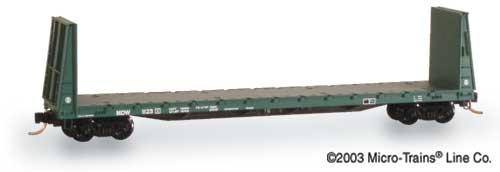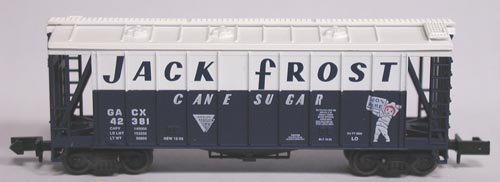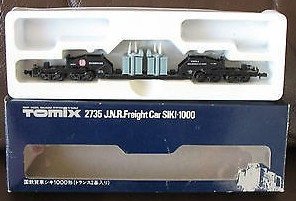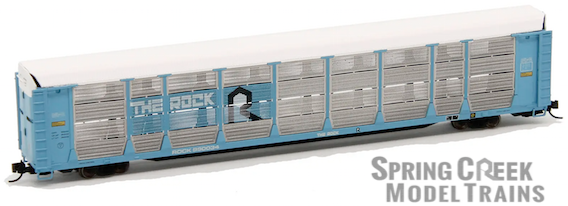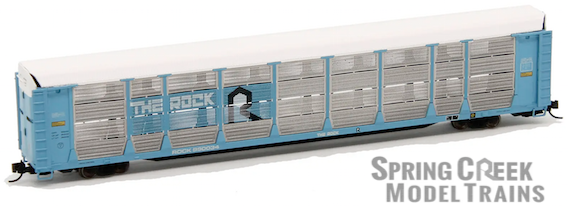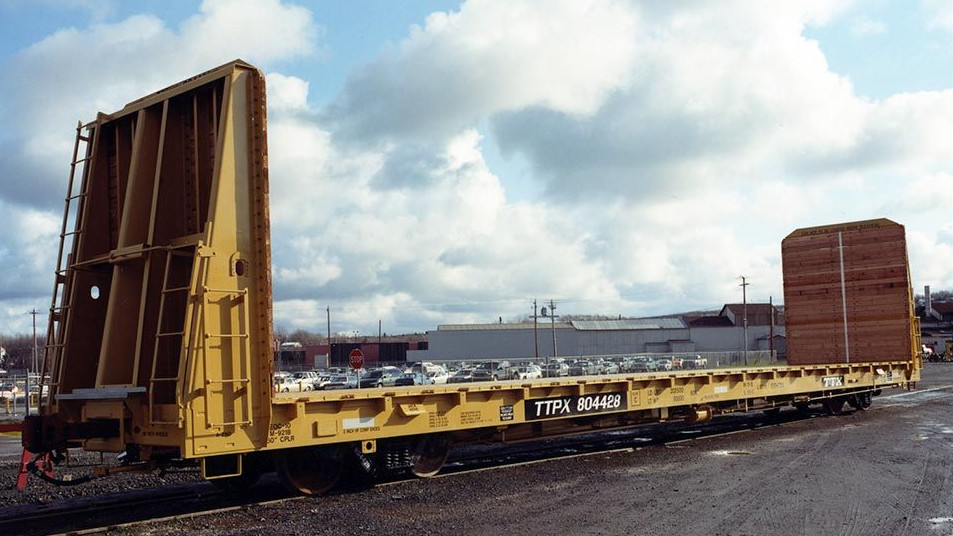Prototype History: Among the earliest types of freight cars, flatcars continue to serve as a valuable part of railroading. Flatcars are used to move a wide variety of loads which do not require protection from weather. These cars, are constructed with steel underframes, wood floors and stake pockets on the sides and ends for fastening tie-downs that keep loads from shifting.
Bulkhead flat cars are a specialized type of flatcar designed which includes reinforced end-walls (bulkheads) to prevent loads from shifting past the ends of the car.
Bulkhead flat cars are a specialized type of flatcar designed which includes reinforced end-walls (bulkheads) to prevent loads from shifting past the ends of the car.
Road Name History: 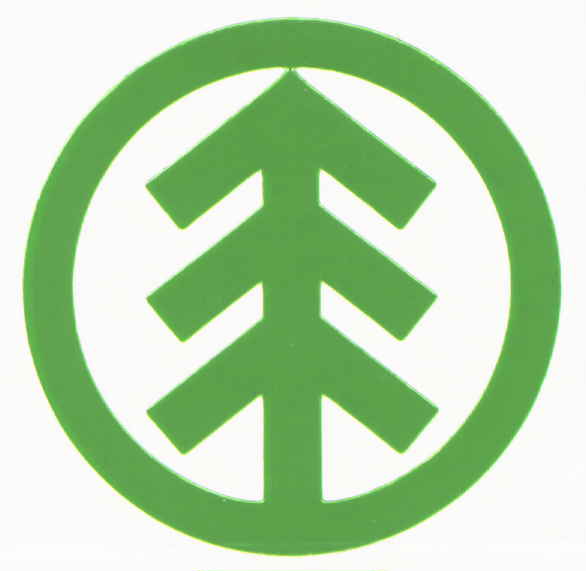 Minnesota Dakota and Western Railway (reporting mark MDW) is a shortline railroad operating 4 miles of track between International Falls and Ranier, Minnesota as well as between International Falls and Fort Frances, Ontario via the Fort Frances' International Falls International Bridge, which is jointly owned by MDW and Abitibi Consolidated. The railroad serves the paper mills in both International Falls and Fort Frances. The railroad interchanges with Canadian National Railway at Ranier.
Minnesota Dakota and Western Railway (reporting mark MDW) is a shortline railroad operating 4 miles of track between International Falls and Ranier, Minnesota as well as between International Falls and Fort Frances, Ontario via the Fort Frances' International Falls International Bridge, which is jointly owned by MDW and Abitibi Consolidated. The railroad serves the paper mills in both International Falls and Fort Frances. The railroad interchanges with Canadian National Railway at Ranier.
In 2005 the railroad handled 11,841 carloads of wood pulp, pulpwood, chemicals, raw materials and finished paper. The railroad has a fleet of more than 3100 railcars.
Originally a subsidiary of Boise Cascade designed to serve its paper mills, the MDW was created in 1910; the company had been incorporated in 1902 as the International Bridge and Terminal Company (reporting mark IBT). The Canadian company, however, retains that name.
In August 2006, Boise Cascade announced that MDW would be sold to the Watco Companies, a company specialising in shortlines; however, the sale was never closed.
In February 2008, Boise Cascade spun off its paper, packaging, newsprint and transportation operations, including MDW, to a new company, Boise Inc.

In 2005 the railroad handled 11,841 carloads of wood pulp, pulpwood, chemicals, raw materials and finished paper. The railroad has a fleet of more than 3100 railcars.
Originally a subsidiary of Boise Cascade designed to serve its paper mills, the MDW was created in 1910; the company had been incorporated in 1902 as the International Bridge and Terminal Company (reporting mark IBT). The Canadian company, however, retains that name.
In August 2006, Boise Cascade announced that MDW would be sold to the Watco Companies, a company specialising in shortlines; however, the sale was never closed.
In February 2008, Boise Cascade spun off its paper, packaging, newsprint and transportation operations, including MDW, to a new company, Boise Inc.
Brand/Importer Information: Micro-Trains is the brand name used by both Kadee Quality Products and Micro-Trains Line. For a history of the relationship between the brand and the two companies, please consult our Micro-Trains Collector's Guide.
Manufacturer Information:  Micro-Trains Line split off from Kadee Quality Products in 1990. Kadee Quality Products originally got involved in N-Scale by producing a scaled-down version of their successful HO Magne-Matic knuckle coupler system. This coupler was superior to the ubiquitous 'Rapido' style coupler due to two primary factors: superior realistic appearance and the ability to automatically uncouple when stopped over a magnet embedded in a section of track. The success of these couplers in N-Scale quickly translated to the production of trucks, wheels and in 1972 a release of ready-to-run box cars.
Micro-Trains Line split off from Kadee Quality Products in 1990. Kadee Quality Products originally got involved in N-Scale by producing a scaled-down version of their successful HO Magne-Matic knuckle coupler system. This coupler was superior to the ubiquitous 'Rapido' style coupler due to two primary factors: superior realistic appearance and the ability to automatically uncouple when stopped over a magnet embedded in a section of track. The success of these couplers in N-Scale quickly translated to the production of trucks, wheels and in 1972 a release of ready-to-run box cars.
Micro-Trains Line Co. split off from Kadee in 1990 to form a completely independent company. For this reason, products from this company can appear with labels from both enterprises. Due to the nature of production idiosyncrasies and various random factors, the rolling stock from Micro-Trains can have all sorts of interesting variations in both their packaging as well as the products themselves. When acquiring an MTL product it is very important to understand these important production variations that can greatly enhance (or decrease) the value of your purchase.
Please consult our Micro-Trains Collector's Guide

Micro-Trains Line Co. split off from Kadee in 1990 to form a completely independent company. For this reason, products from this company can appear with labels from both enterprises. Due to the nature of production idiosyncrasies and various random factors, the rolling stock from Micro-Trains can have all sorts of interesting variations in both their packaging as well as the products themselves. When acquiring an MTL product it is very important to understand these important production variations that can greatly enhance (or decrease) the value of your purchase.
Please consult our Micro-Trains Collector's Guide
Item created by: Lethe on 2015-05-31 17:46:30. Last edited by George on 2024-01-26 20:28:48
If you see errors or missing data in this entry, please feel free to log in and edit it. Anyone with a Gmail account can log in instantly.
If you see errors or missing data in this entry, please feel free to log in and edit it. Anyone with a Gmail account can log in instantly.


